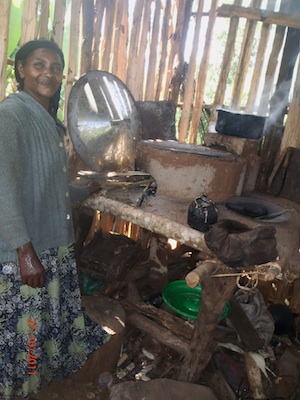Forest preservation through wood-saving stoves
 Kafa is the birthplace of wild coffee, Coffea arabica, where it has been consumed for more than 1,000 سنوات. There are now close to 5,000 wild varieties of coffee in this biodiversity hotspot. A unique coffee culture is deeply ingrained in the Ethiopian economy and history. This culture is a key element of the participatory forest management scheme created in the Kafa Biosphere Reserve to avoid deforestation and boost economic development.
Kafa is the birthplace of wild coffee, Coffea arabica, where it has been consumed for more than 1,000 سنوات. There are now close to 5,000 wild varieties of coffee in this biodiversity hotspot. A unique coffee culture is deeply ingrained in the Ethiopian economy and history. This culture is a key element of the participatory forest management scheme created in the Kafa Biosphere Reserve to avoid deforestation and boost economic development.
نابو (The German Nature and Biodiversity Conservation Union) and its partners have worked towards the preservation of these forests obtaining the establishment of the UNESCO Kafa Biosphere Reserve in June 2010 and implementing the project: “Climate Protection and Preservation of Primary Forests – A Management Model using the Wild Coffee Forests in Ethiopia as an Example“.
تحقيق المشروع لإنتاج وتوزيع 11200 توفير الطاقة مواقد للسكان على الرغم من جهد تعاوني مع وزارة الطاقة. 70 تم تدريب الشباب العاطلين عن العمل تنظيم وتجهيز ونشر في 11 الإنتاج و 25 مواقع الأقمار الصناعية.
The dependency on biomass energy: a driving force for deforestation
Only 40 منذ سنوات, بعض 40% of the Ethiopian land surface was occupied by forests. اليوم, less than 3% remains, largely in the Kafa coffee biosphere reserve, which still boasts large areas of mountainous afromontane cloud forest. The forest ecosystem makes an important contribution to the livelihoods of people in the area. It provides wild coffee, valuable spices and honey from wild bees. It also contains some 25 million tons carbon in above-ground biomass. بعض 600,000 tons of carbon could be removed from the atmosphere annually through natural forest growth – if the forest remains intact. But it is endangered due to clear-cutting for smallholder agriculture and industrial coffee and tea plantations, and the intensive use of biomass.
يلبي إثيوبيا حاليا لل 96 في المئة من احتياجاته من الطاقة باستخدام الكتلة الحيوية. ونظرا لهذه الحقيقة كثير من الأسر تلبية الطلب من خلال قطع الأشجار تشكل الغابات الطبيعية المتاحة / الأحراج والأراضي شجيرة. وقد ذكر هذا الوضع باعتباره واحدا من القوى الدافعة لإزالة الغابات. مماثلة إلى أجزاء أخرى من البلاد من الناس كفى نستخدم بشكل رئيسي المنتجات الخشبية لاطلاق النار. الحطب يأتي من الغابات القريبة. على رأس ذلك, يتم استخدام وقود الكتلة الحيوية معظمها غير فعال. وهذا له علاقة مباشرة مع دخل الأسرة وميزانية الوقت. وأكثر غير فعال يتم استخدام الخشب لمزيد من الوقت من النساء والأطفال سوف تنفق على جمع الحطب.
There is no electric power plant in the Biosphere Reserve. Electricity is supplied only to a few areas of the reserve by an external hydro-power plant.
Energy-efficient stoves and other renewable energy sources
Among the activities carried out by NABU’s Climate and Forest Project to mitigate the impact of meeting energy requirement using biomass, there are two main lines of action: promotion of community plantations with fast-growing tree species as fuel wood and introduction of efficient wood-burning stoves.
In this last case, the target of the project is to introduce energy-saving stoves to the communities in Kafa Biosphere Reserve. 11200 stoves were distributed until September 2012. The plan says that 10000 stoves will be distributed to households with high wood consumption by September 2012. التقنية الجديدة من هذه المواقد ليس فقط يقلل من كمية الخشب اللازمة للطهي بمقدار النصف, كما أنه يوفر الغابات, الوقت للمستخدم وتنتج أقل من الدخان والنار. The stoves are therefore a source of great relief to the people and the forest and have been very well received.
لإنتاج وتوزيع مواقد تعمل نابو عن كثب مع إدارة المنطقة كفى للمياه, المناجم والطاقة. وكجزء من هذا التعاون 70 تم تدريب الشباب العاطلين عن العمل كمنتجين موقد ودعم لبدء الأعمال التجارية إنتاجها.
In collaboration with GLEN (Global Education Network of Young Europeans) a study has been conducted on alternative energy sources where coffee husk briquets, ظهرت الغاز الحيوي والطاقة الشمسية ونفس القدر من الأهمية.
Annually, in the area of biosphere reserve, حول 100 t of coffee husk is produced. This represents an ideal material for briquetting. But not only the coffee husk: dry leftovers from other crops processing (e.g. maize, sorghum etc.) can be used as well. Another source is biogas production, based on two big potential sources: cattle dung and coffee pulp.
The Kafa Water, Mining and Energy Department has started to implement some renewable energy programs in its “5 years strategic plan” – starting from 2011. 450 PV solar panels were distributed until September 2012.
Lessons learned and potential replicability
The acceptance of wood-saving stoves is very high and they are easily adapted by users. Within this context, local communication and education are essential. The importance of the training programme for young people to help them expand their own knowledge of climate and forest protection is recognised. In turn, they can share this knowledge and raise the awareness of other members of their communities.
With regard to energy, solar power has a high potential and there are multiple benefits of using solar energy in the area. But before installing new panels it is necessary to prepare and train technical staff that will work in the zone.
The successful results of this project may have a significant impact on other areas of the region with similar characteristics and needs. This would be the case of Yayu Biosphere Reserve, also in Ethiopia, and of other similar areas, like the Ituri region in the Democratic Republic of Congo.

















